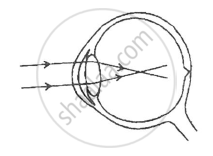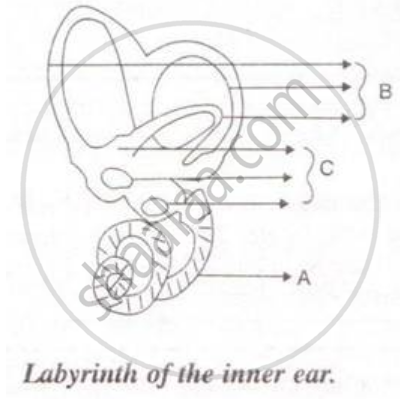Advertisements
Advertisements
Question
Differentiate between the Rods and Cones of Retina (Type of pigment)
Solution
Rods and Cones of Retina (Type of pigment):
| Rods | Cones |
| Rods produce rhodopsin. | Cones produce iodopsin. |
APPEARS IN
RELATED QUESTIONS
Given below is a diagram depicting a defect of the human eye, study the same and then answer the questions that follow:

(i) Name the defect shown in the diagram.
(ii) What are the two possible that cause this defect?
(iii) Name the type of lens used to correct this defect.
(iv) With the help of a diagram show how the defect shown above is rectified using a suitable lens.
Given in the box below are a set of 14 biological terms. Of these, 12 can be paired into 6 matching pairs. Out of the six pairs, one has been done for you as an example.
Example : endosmosis - Turgid cell.
Identify the remaining five matching pairs :
| Cushing’s syndrome, Turgid cell, Iris, Free of rod and cone cells, Colour of eyes, Hypoglycemia, Active transport, Acrosome, Addison’s disease, Blind spot, Hyperglycemia, Spermatozoa, Endosmosis, Clotting of blood. |
State the exact location of the Organ of Corti
Name the following:
The tube which connects the cavity of the middle ear with the throat.
Differentiate between members of the following pair with reference to what is asked in bracket.
Semi-circular canal and cochlea (Senses perceived)
State whether the following statements are true (T) or false (F). If false, correct them by changing any one single word in each.
Deafness is caused due to rupturing of the pinna.
With reference to the human ear, answer the question that follow:
Name the three small bones present in the middle ear. What is the biological term for them collectively ?
Name the tube which connects the middle ear to throat.
Name the nerve which carries electrical impulses from the cochlea of ear to the brain.
Name the following:
Part of internal ear related to balance.
Write whether the following is true or false:
Vitreous chamber is present in ear in humans.
Given below is a diagram of a part of the human ear. Study the same and answer the question that follow:

Name the parts labeled A, B and C in the diagram.
Complete the following sentence with appropriate word :
________ is the organ of balance and hearing in the body.
The part of the ear that collects the sound from the surroundings is ______.
Assertion: Human beings Cannot hear infrasonic sounds.
Reason: Sound with a frequency less than 20 Hz is called infrasonic sound.
Note the relationship between the first two words and suggest the suitable word/words for the fourth place.
Semi-circular canal : Ampulla :: Cochlea : ______.
With reference to human ear answer the question that follow:
Name the part of the ear associated with Static balance.
With reference to human ear answer the question that follow:
Name the part of the ear associated with dynamic balance.
With reference to human ear answer the question that follow:
Name the part of the ear associated with the amplification of vibrations.
- Draw a neat and well labelled diagram of the membranous labyrinth found in the inner ear.
- Based on the diagram drawn above in (i), give a suitable term for each of the following descriptions:
- The structure responsible for hearing.
- The sensory cells that help in hearing.
- The membrane-covered opening that connects the middle ear to inner ear.
- The nerves that carry impulses from the ear to the brain.
- The tube which equalises the air pressure on either side of the ear drum.
